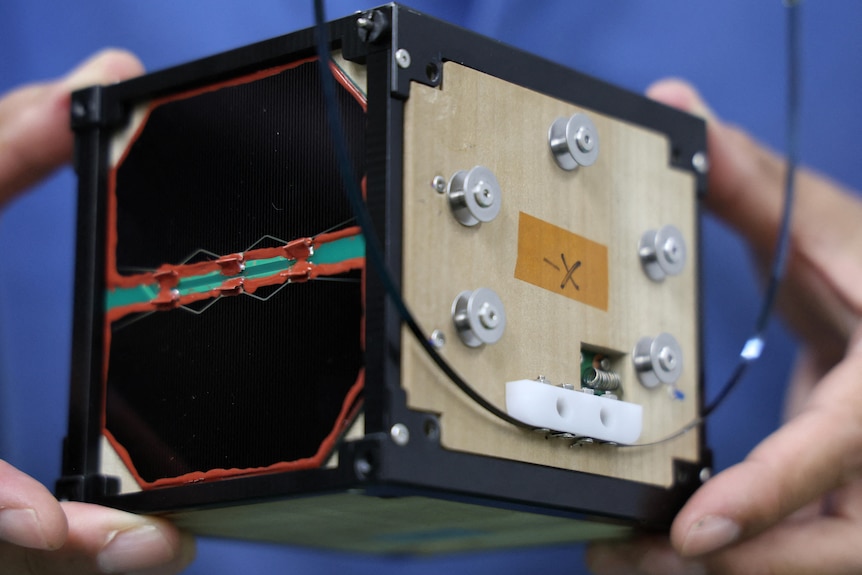World's First Wooden Satellite LignoSat Redefines Space Exploration
Explore how LignoSat, the world's first wooden satellite, is pioneering sustainable materials for future human habitats on the Moon and Mars.

Key Points
- LignoSat, the first wooden satellite, aims to demonstrate the viability of timber for sustainable space exploration on the Moon and Mars.
- Constructed from honoki wood using traditional Japanese techniques, LignoSat is designed to minimize environmental impact during re-entry.
- The satellite will collect crucial data on wood's durability in extreme space conditions, paving the way for future habitats and applications.
In a groundbreaking moment for both technology and sustainability, Japanese researchers successfully launched the world’s first wooden satellite, LignoSat, into space. This historic mission is more than just a novel scientific achievement; it represents a pivotal step towards redefining the materials used in outer space exploration and habitation. Built by scientists from
in partnership with Sumitomo Forestry, LignoSat is set to explore the potential of timber in the vacuum of space, ultimately paving the way for future human habitats on the Moon and Mars.

The objectives of the LignoSat mission are ambitious yet attainable. The satellite, a compact 10cm cube made of honoki wood, is designed to withstand the extreme conditions of space, including temperature fluctuations ranging from -100 to 100 degrees Celsius within just 45 minutes as it orbits Earth. This resilience is crucial for future exploration efforts, where traditional materials may not hold up as well.
The Vision Behind LignoSat
At the heart of this initiative is Takao Doi, an astronaut and researcher at Kyoto University. He believes that using timber could revolutionize how we think about construction and habitation in space. “With timber, a material we can produce by ourselves, we will be able to build houses, live and work in space forever”, Doi remarked.
This vision extends to a 50-year plan that includes planting trees and constructing wooden habitats on the Moon and Mars. By demonstrating that wood can serve as a viable material in space, the team hopes to shift the paradigm of materials used in space travel.
Environmental Benefits of Wooden Satellites
One of the most striking features of LignoSat is its potential to mitigate environmental impacts. Traditional metal satellites contribute to space debris and, upon re-entry, release harmful particles like aluminum oxide into the atmosphere. In contrast, wooden satellites like LignoSat are designed to burn up completely upon re-entry, minimizing pollution.
Research has shown that the honoki wood used in LignoSat actually displays greater durability in space than on Earth, primarily because there is no water or oxygen that could lead to degradation or fire. This resilience underscores the satellite's role not just as a scientific experiment, but also as a model for future sustainable practices in space exploration.
Technical Innovations and Research Opportunities
Building LignoSat involved traditional Japanese woodworking techniques that eschew screws and glue, leading to a completely biodegradable product. Professor Koji Murata of Kyoto University pointed out, “Early 1900s airplanes were made of wood. A wooden satellite should be feasible, too”. This emphasis on tradition combined with cutting-edge technology offers a compelling narrative of innovation.
Moreover, LignoSat is equipped to collect a wealth of data during its six-month mission in orbit. It will measure how well wood resists the extreme temperatures of space and assess wood’s effectiveness in reducing the impact of space radiation on semiconductors. The outcomes of this research could have profound implications, not only for space exploration but also for Earth-bound applications, such as data center construction.
Looking Toward the Future
As civilization sets its sights on the Moon and Mars, the idea of using renewable materials in space infrastructure becomes ever more appealing. “Metal satellites might be banned in the future”, Doi warns, underscoring the need for innovative solutions like LignoSat. By championing timber as a material for future missions, Japan's scientists could inspire a broader shift in the space industry towards sustainability.
The success of LignoSat could invigorate not only the aerospace sector but also the timber industry. As we continue to explore and potentially inhabit other celestial bodies, integrative efforts that marry tradition with innovation will be crucial. LignoSat stands as a beacon of possibility, illustrating that the future of space may be bright, not only with technological advancements but with the warmth and dependability of wood as a foundational element.
In wrapping up, the launch of LignoSat symbolizes a significant step forward in sustainable space exploration. Researchers are hopeful that this pioneering mission will pave the way for new approaches to habitation on other planets, all while emphasizing the need for ecological responsibility. As humanity ventures further into the cosmos, the utilization of renewable materials like wood may prove essential for long-term exploration and settlement.


